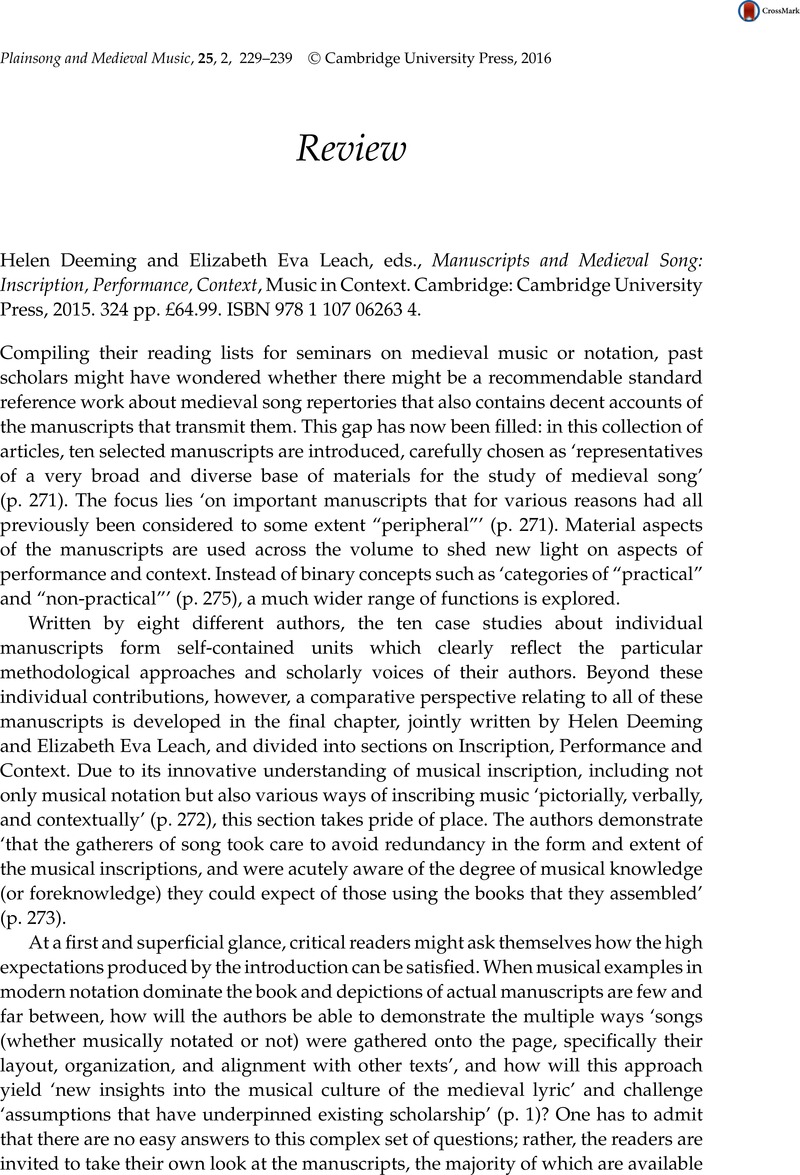No CrossRef data available.
Article contents
Helen Deeming and Elizabeth Eva Leach , eds., Manuscripts and Medieval Song: Inscription, Performance, Context, Music in Context. Cambridge: Cambridge University Press, 2015. 324 pp. £64.99. ISBN 978 1 107 06263 4.
Review products
Published online by Cambridge University Press: 14 October 2016
Abstract

- Type
- Reviews
- Information
- Copyright
- Copyright © Cambridge University Press, 2016
References
1 For the terminology, see Gumbert, J. Peter, ‘Codicological Units: Towards a Terminology for the Stratigraphy of the Non-Homogeneous Codex’, Segno e Testo 2 (2004), 17–42 Google Scholar.
2 For the sake of completeness, attention should here be drawn to the extensive treatment of dialectal, philological and historical aspects of De Heinrico in the Würzburg doctoral dissertation by Herweg, Mathias, Ludwigslied, De Heinrico, Annolied. Die deutschen Zeitdichtungen des frühen Mittelalters im Spiegel ihrer wissenschaftlichen Rezeption und Erforschung, Imagines medii aevi 13 (Wiesbaden, 2002), 181–270 Google Scholar.
3 For the development in Italy see, for example, Huck, Oliver, ‘Die “Entstehung des Komponisten” und der “Schritt in die Schrift”. Überlieferung und Edition der Musik des frühen Trecento’, in Text und Autor, Beihefte zu editio 15, ed. Henkes, Christiane and Saller, Harald with Richter, Thomas (Tübingen, 2000), 97–114 Google Scholar.
4 Earp, Lawrence, ‘Machaut's Role in the Production of Manuscripts of His Works’, Journal of the American Musicological Society 42 (1989), 461–503 CrossRefGoogle Scholar, at 461.
5 For a first overview of the layout of the early motets see Huck, Oliver, ‘The Layout of the Early Motet’, Journal of the Alamire Foundation 7/1 (2015), 11–32 CrossRefGoogle Scholar.
6 David Catalunya is presently undertaking a full study of this manuscript.
7 For accounts of the spectrum of controversy concerning Orff's position during the Nazi period, see, for example, Kater, Michael H., ‘Carl Orff im Dritten Reich’, Vierteljahrshefte für Zeitgeschichte 43 (1995), 1–35 Google Scholar, and Kowalke, Kim H., ‘Burying the Past: Carl Orff and his Brecht Connection’, Musical Quarterly 84 (2000), 58–83 CrossRefGoogle Scholar. For a broader overview of the reception, see, for example, the collection of essays and primary sources in Willnauer, Franz, Carmina burana von Carl Orff: Entstehung, Wirkung, Text, Serie Musik 8220 (Mainz, 1995)Google Scholar.
8 Hanau, Eva, ‘Nationalsozialistische Kulturpolitik in Frankfurt am Main und Carl Orff’, Archiv für Musikwissenschaft 56 (1999), 245–57CrossRefGoogle Scholar.
9 All the concordances are also easily accessible through the CPI conductus database created in the course of the now completed AHRC-funded research project ‘Cantum pulcriorem invenire: Thirteenth-Century Music and Poetry’, directed by Mark Everist, in which our most recent discoveries since 2010 have been incorporated (http://catalogue.conductus.ac.uk).
10 Mentioned in Maschke, Eva M., ‘Neue Conductus-Fragmente aus dem ehemaligen Dominikanerkloster in Frankfurt am Main’, Studi Musicali, n.s. 1 (2010), 295–312 Google Scholar, at 303. For a facsimile and a discussion of E-SAu 226, see Bevilacqua, Gregorio, ‘Conductus or Motet? A New Source and a Question of Genre’, Musica disciplina 58 (2013), 9–27 Google Scholar; the beginning of Dic Christi veritas in comparison to the tenor of I-Fl Plut. 29.1, fol. 200 is presented on p. 16.
11 Controversial papers were read at the 40th Medieval and Renaissance Music Conference, Nottingham, July 2012: Gregorio Bevilacqua, ‘The Eloquence of Absence’, and Maschke, Eva M., ‘Treasures and Trash in Cistercian Libraries: Newly-Discovered Conductus Fragments in a Clairvaux Manuscript’. Bevilacqua's questionable hypothesis is now published (‘The Earliest Source of Notre-Dame Polyphony? A New Conductus Fragment from the Early Thirteenth Century’, Music and Letters 97 (2016), 1–41)Google Scholar.
12 On D-F Fragm. lat. VI. 41, found in the incunable D-F Inc. Oct. 294, see Staehelin, Martin, Conductus-Fragmente aus einer Notre Dame-Handschrift in Frankfurt a. M., Nachrichten der Akademie der Wissenschaften in Göttingen, 1. Philologisch-Historische Klasse, 8 (Göttingen, 1987), 179–92Google Scholar, and on the connection between this fragment and US-NYcub N-66 see my ‘Neue Conductus-Fragmente’.
13 On I-Rc 1404, see, for example, Saxl, Fritz, ‘A Spiritual Encyclopedia of the Later Middle Ages’, Warburg Journal 5 (1942), 83–134 Google Scholar. A manuscript description of D-B Cod. theol. lat. fol. 312 is found in Rose, Valentin, Verzeichniss der lateinischen Handschriften der Königlichen Bibliothek zu Berlin, II: Die Handschriften der Kurfürstlichen Bibliothek und der Kurfürstlichen Lande, i, Die Handschriften-Verzeichnisse der Königlichen Bibliothek zu Berlin 13 (Berlin, 1901), 367–73Google Scholar (no. 501).
14 In my own research, I have recently drawn attention to another underexplored area, the connection between material culture and music: see Maschke, Eva M., ‘ Porta salutis ave: Manuscript Culture, Material Culture, and Music’, Musica disciplina, 58 (2013), 167–230 Google Scholar.
15 Much as we may welcome the comprehensive citation of German-language literature, it is unfortunate that citations from German are simply translated into English without making this transparent.
16 Elizabeth Eva Leach keeps the scholarly community abreast of this project in her blog: https://eeleach.wordpress.com/category/douce-308-project/.
17 For a critical review of the possibilities and limits of a manuscript-centred approach, see Haug, Andreas, ‘Handschrift und Geschichte. Vorwiegend Methodisches zum Thema “Mainz in der Musikgeschichte des zehnten Jahrhunderts”’, in Musik der mittelalterlichen Metropole. Räume, Identitäten und Kontexte der Musik in Köln und Mainz, ca. 900–1400. Tagungsbericht Mainz/Köln Oktober 2014, Beiträge zur rheinischen Musikgeschichte 179, ed. Kolb, Fabian (Kassel, 2016), 1–23 Google Scholar. My sincere thanks to Andreas Haug for sharing this article prior to publication.




